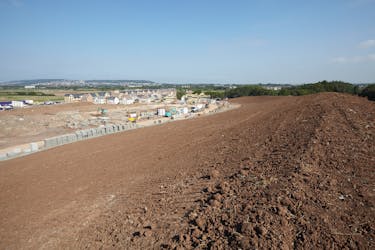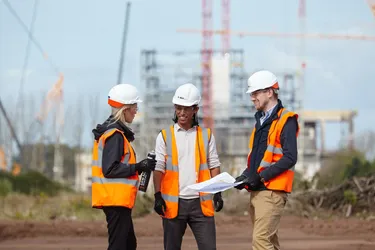
Before any walls go up or foundations are poured, the real groundwork takes place. Earthworks are the first and most crucial step in turning a raw site into a construction-ready space.
Proper site preparation ensures the stability and longevity of a project, reducing risks like foundation failure, water drainage issues, and costly structural repairs down the line. With expert planning and execution, earthworks create the solid base every successful build depends on.
What is earthworks?
Earthworks involve more than just moving dirt. This specialised process includes excavating, reshaping, and stabilising the land to meet the unique requirements of a construction project. From large-scale infrastructure developments to residential builds, earthworks ensure the ground is properly prepared to support everything that follows.
The process includes a range of key tasks, such as excavation, grading, drainage installation, and site clearance. Each step requires precise execution and a deep understanding of the site’s geological and environmental conditions. By addressing potential challenges early, professional earthworks teams help prevent issues that could compromise the structural integrity of a project.
What are the key components of professional earthworks?
Site preparation and excavation
Excavation is a critical first step in any construction project. It involves removing excess material, shaping the land, and ensuring the site is level and stable. Modern excavation techniques use GPS-guided machinery and digital mapping and surveying using drone technologyto achieve precise results. This ensures that the ground is prepared according to engineering specifications while minimising disruption to the surrounding environment.
Grading and levelling
Once excavation is complete, grading and levelling create a smooth, even surface for construction. This step is essential for ensuring proper drainage and preventing issues like uneven settling or water pooling. Laser-guided equipment helps achieve the exact slope and elevation needed, reducing risks and improving long-term site stability.
Drainage and trenching
Effective water management is crucial in construction. Poor drainage can lead to soil erosion, foundation damage, and long-term structural issues. Trenching and drainage systems are designed to control water flow and prevent accumulation in unwanted areas. By analysing local hydrological conditions, earthworks teams develop tailored solutions that protect the integrity of the site.
Site clearance and demolition
Before new construction can begin, existing structures and debris must be removed efficiently and safely.
Professional site clearance involves more than demolition. It requires careful planning to manage waste responsibly and ensure the site is ready for development. This process includes assessing potential hazards, removing unwanted materials both above and below ground, and preparing the ground for the next phase of construction.
Landscaping and final site preparation
Beyond basic earthworks, many projects require additional landscaping to create a functional and aesthetically pleasing environment. This might involve contouring the land, installing green spaces, or reinforcing slopes to prevent erosion. Proper landscaping not only enhances the visual appeal of a site but also contributes to its long-term stability and usability.
The role of technology in modern earthworks
Technology is transforming the construction industry, and earthworks are no exception. Advanced tools and techniques improve efficiency, accuracy, and safety across every stage of the process. Some of the most impactful innovations include:
GPS-guided machinery for precise excavation and grading
Real-time geological mapping to assess site conditions before work begins
Digital terrain modelling for improved project planning and risk reduction
Laser-guided levelling systems to create stable, even surfaces
Modern drone technology to quickly survey ground conditions which help model the requirements of the cut/fill on site
These technologies don’t just enhance precision. They also help reduce material waste, lower costs, and minimise environmental impact. By leveraging digital solutions, earthworks professionals can make more informed decisions and optimise construction outcomes.
Tackling environmental considerations
Sustainability is a growing priority in the construction industry. Earthworks must balance technical requirements with environmental responsibility, ensuring that projects minimise their ecological impact. Best practices in sustainable earthworks include:
Soil preservation and reuse to reduce the need for new materials
Recycling and repurposing construction waste to minimise landfill disposal and reuse of materials
Energy-efficient machinery to lower carbon emissions
Erosion control measures to protect local ecosystems
By integrating these strategies, professional earthworks teams help ensure that construction projects align with modern environmental standards while maintaining long-term site stability.
What are the consequences of poor earthworks?
Skipping or mishandling earthworks can have serious consequences. Poor ground preparation increases the risk of structural instability, leading to foundation shifting, water damage, and costly repairs. Common issues caused by inadequate earthworks include:
Uneven settling, which can lead to cracks in foundations and walls
Drainage problems, causing water buildup and erosion
Increased maintenance costs, as unstable ground requires frequent repairs
Safety hazards, including structural failures and site instability
Increase project cost due to material mishandling and poor segregation of materials
Investing in professional earthworks from the outset helps prevent these issues, saving time and money in the long run.
Laying the groundwork for success
Earthworks are the foundation of every successful construction project. By combining technical expertise, cutting-edge technology, and a commitment to quality, professional earthworks projects can transform raw landscapes into stable, build-ready sites.
Ensuring that this crucial phase is handled correctly from the start sets the stage for a smooth, efficient, and long-lasting construction process. To learn how the team here at B&A can help, get in touch today to speak to an expert.


